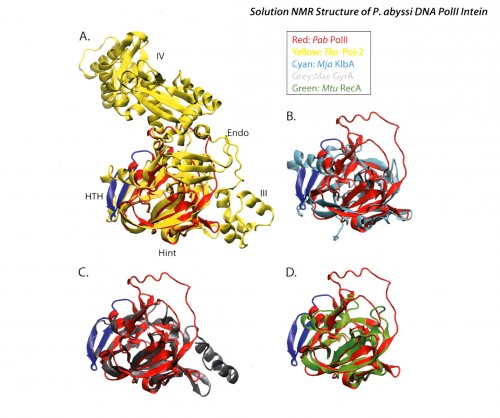 RESEARCHERS MODEL the three-dimensional structure of the Pab PolII intein.
RESEARCHERS MODEL the three-dimensional structure of the Pab PolII intein.Structure-function dynamics form the basis of Professor Chunyu Wang’s research. Wang explores Alzheimer’s disease and protein splicing mainly through the use of nuclear magnetic resonance.
Causing memory loss, Alzheimer’s disease is the most common type of dementia in elderly people affecting about 10 percent of people over 65 years of age. Two things in the affected individual characterize the disease: senile plaque and neurofibrillary tangle.
Senile plaque is composed of a myriad of proteins and peptides. The focus of Wang’s research lies in one of these proteins, called amyloid beta peptide. Aß forms senile plaque through a process called aggregation, where Aß molecules stick together and form a proteinaceous deposit.
“Senile plaque is the pathologic hallmark of Alzheimer’s disease,” Wang said. “We’re interested in how Aß forms this plaque. It’s in the matrix of the brain, and it has toxicity. It can kill neurons and will eventually disrupt the neuro-network responsible for memory.”
With a surplus of Aß, Alzheimer’s disease will inevitably occur. For example, in Down’s syndrome, the tripled chromosome 21 has a gene called amyloid precursor protein. APP codes for the precursor to Aß, ultimately generating an excess of Aß. Unsurprisingly, Down’s syndrome patients develop the earliest onset Alzheimer’s disease.
Wang’s lab studies the structure dynamics of Aß by NMR. It can look at individual atoms in the protein with atomic resolution. For Aß, it tries to look at the structure and dynamics and understand why the molecules aggregate. There are mutations within Aß that can cause Alzheimer’s. By comparing the Y-type with the mutant via NMR, the lab can see how the structures differ.
When proteins are examined under the NMR magnets, they become polarized and give off a signal. With the use of simulation and NMR, Wang’s lab has determined the Aß peptide structure.
“Once we know the shape of the protein, we can try and fit a small molecule to try and fit that shape,” said Wang. “Then, we can try and prevent it from, for example, aggregating. That’s our major goal here: to study the structure and dynamics of amyloid beta peptide, to understand how it aggregates, and to see how disease causes mutations and changes its properties.”
Wang’s lab also studies protein splicing, a post-translational modification. The process occurs similarly to RNA splicing. In RNA splicing, there are introns and exons. In protein splicing, there are inteins and exteins. A precursor protein comprises of a middle intein and two flanking exteins. The intein cuts itself out of the precursor molecule and joins the two exteins together with a peptide. Since no cofactors or gene input is necessary for the splicing, the mechanism remains unclear.
Recently, the lab determined the structure for the PolII intein from the hyperthermophilic Pyrococcus abysii via NMR.
“When you study the function of an organ or a certain muscle, you want to know its structure,” said Wang. “So, you explore the structure-function relationship. We’re examining [whether] the same thing happens for proteins and other big molecules in our bodies.”
